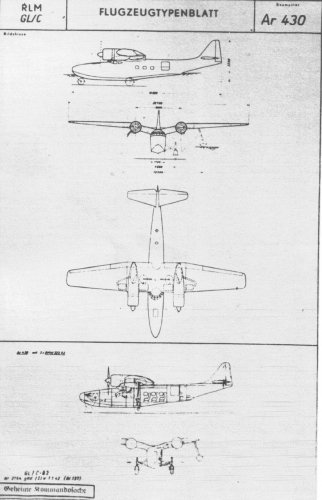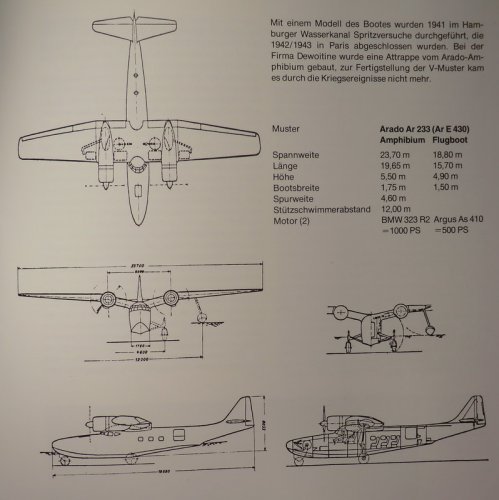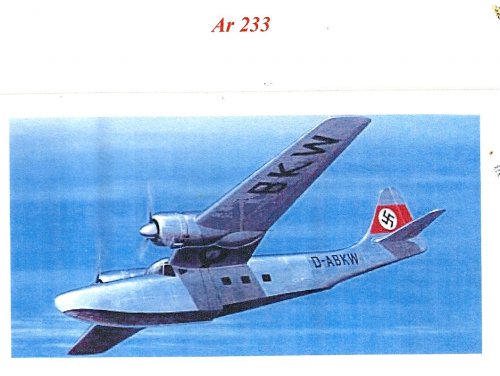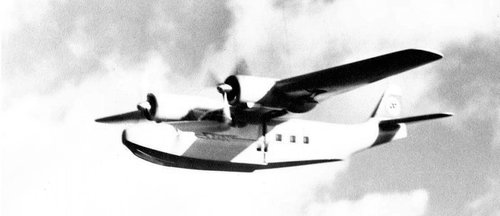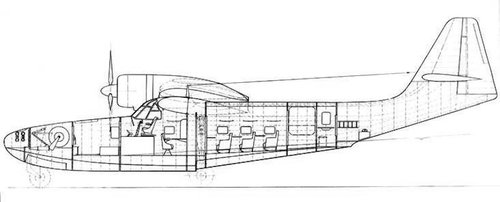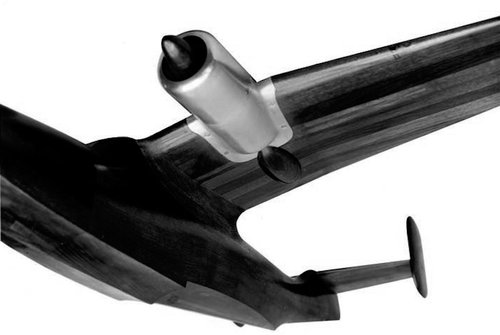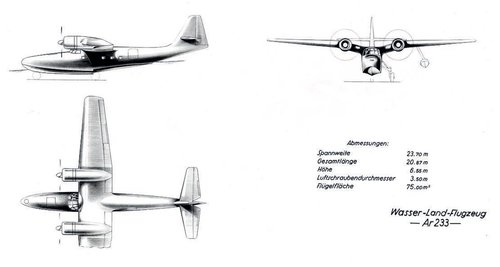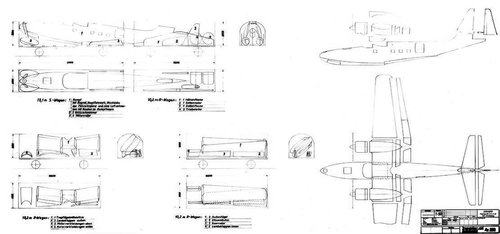You are using an out of date browser. It may not display this or other websites correctly.
You should upgrade or use an alternative browser.
You should upgrade or use an alternative browser.
Arado Ar 430
- Thread starter baja
- Start date
- Joined
- 6 November 2010
- Messages
- 5,264
- Reaction score
- 5,518
E 233 project started in 1940, Ar 430 designation by RLM.
Two crew, six to eight passengers.
All metal construction amphibian.
Retractable wheel landing gear and floats
Span 23.79 m
Length 20.92 m
All-up weight 9434 kg
Initially proposed power plant 2 x Bramo 323 R2, 1000 hp each
Maximum speed 313 km/h
Electrical de-icing gear for wing leading edges.
Air conditioning for deployment to Mediterranean
Design of wings and tail started in january 1941. Spray testing of a scale model conducted at DVL's Institut für Seeflugswesen, Hamburg. In 1943 the design was handed over to the French Dewoitine firm for further development. In April that year, another French firm, SIPA, delivered tails and wing flaps.
First prototype was to be fitted with 700 hp Gnome-Rhône 14M engines. In mid 1944, shortly before completion, the project was cancelled because of the Normandy landings.
Source: 'Die Deutschen Luftfahrt - Arado Flugzeuge - Vom Doppeldecker zum Strahlflugzeug' by Jörg Armin Kranzhoff, Bernard & Graefe Verlag, 2001
Two crew, six to eight passengers.
All metal construction amphibian.
Retractable wheel landing gear and floats
Span 23.79 m
Length 20.92 m
All-up weight 9434 kg
Initially proposed power plant 2 x Bramo 323 R2, 1000 hp each
Maximum speed 313 km/h
Electrical de-icing gear for wing leading edges.
Air conditioning for deployment to Mediterranean
Design of wings and tail started in january 1941. Spray testing of a scale model conducted at DVL's Institut für Seeflugswesen, Hamburg. In 1943 the design was handed over to the French Dewoitine firm for further development. In April that year, another French firm, SIPA, delivered tails and wing flaps.
First prototype was to be fitted with 700 hp Gnome-Rhône 14M engines. In mid 1944, shortly before completion, the project was cancelled because of the Normandy landings.
Source: 'Die Deutschen Luftfahrt - Arado Flugzeuge - Vom Doppeldecker zum Strahlflugzeug' by Jörg Armin Kranzhoff, Bernard & Graefe Verlag, 2001
- Joined
- 31 May 2006
- Messages
- 657
- Reaction score
- 440
Am I seeing this drawing right? The floats appear to retract into the rear of the nacelles. Neat arrangement. Wheeled undercarriage too.
- Joined
- 11 March 2006
- Messages
- 8,626
- Reaction score
- 3,809
From F.Gütschow "Die deutschen Flugboote" a drawing of the same aircraft, which was
planned as a pure flying noat version, too. BTW, the designation is given here as
"Ar 233", and "E 430", the latter one the project number, I think.
The auxiliary floats are recognisable, too.
planned as a pure flying noat version, too. BTW, the designation is given here as
"Ar 233", and "E 430", the latter one the project number, I think.
The auxiliary floats are recognisable, too.
Attachments
- Joined
- 11 March 2006
- Messages
- 8,626
- Reaction score
- 3,809
In Novarra "Die Deutsche Luftrüstung 1933 - 1945" the story of the designation is told different again:
Duringn 1940, it was started as "Arado Entwicklungsbezeichnung Ar 233", what would explain an E 233"
designation. After it was ordered for construction, the designation was changed to "Ar 430" and work
on the first prototype actually begun, but it would have been powered by two Gnôme-Rhône 14M engines,
instead of the BMW Bramo 323, which were originally envisaged. Finishing this prototype was prevented
due to the military situation in 1944.
In "Die deutschen Flugboote" it is mentioned, that a mock-up was built by dewoitine, but that the prototype
wasn't finished.
So maybe work was actually started.
Duringn 1940, it was started as "Arado Entwicklungsbezeichnung Ar 233", what would explain an E 233"
designation. After it was ordered for construction, the designation was changed to "Ar 430" and work
on the first prototype actually begun, but it would have been powered by two Gnôme-Rhône 14M engines,
instead of the BMW Bramo 323, which were originally envisaged. Finishing this prototype was prevented
due to the military situation in 1944.
In "Die deutschen Flugboote" it is mentioned, that a mock-up was built by dewoitine, but that the prototype
wasn't finished.
So maybe work was actually started.
lastdingo
Blogger http://defense-and-freedom.blogspot.de/
newsdeskdan said:The mock-up was probably made byAradoDewoitine, rather thanDewoitineArado. In the photo of the mock-up radio operator's station that all the controls are labelled in both German and French.

WTF? The front wheel!
Is this a steerable propeller for manoeuvering when floating on water!?
- Joined
- 8 March 2009
- Messages
- 1,057
- Reaction score
- 1,299
lastdingo said:newsdeskdan said:The mock-up was probably made byAradoDewoitine, rather thanDewoitineArado. In the photo of the mock-up radio operator's station that all the controls are labelled in both German and French.

WTF? The front wheel!
Is this a steerable propeller for manoeuvering when floating on water!?
It's a wooden mockup
Rather than putting an actual wheel on it, they make a wood/metal frame outline of a wheel
Hi folks,
just found this today:
https://plane-encyclopedia.com/ww2/arado-ar-233/
There are shown many photos and details of the mock-up! And a nice colored profile of what the plane could have looked like.
greetings Baja
just found this today:
https://plane-encyclopedia.com/ww2/arado-ar-233/
There are shown many photos and details of the mock-up! And a nice colored profile of what the plane could have looked like.
greetings Baja
- Joined
- 26 May 2006
- Messages
- 34,922
- Reaction score
- 15,794
Amazing find Baja.
Attachments
- Joined
- 3 June 2006
- Messages
- 3,094
- Reaction score
- 3,966
Thanks to Dan Sharp again!
- Joined
- 11 June 2014
- Messages
- 1,542
- Reaction score
- 2,902
Amazing find Baja.
Well, not that amazing. It's just a summary of my piece on the Ar 233 in Luftwaffe: Secret Designs of the Third Reich (2018). All the images come from that article.
Ok, this i didn't know.
Amazing find Baja.
Well, not that amazing. It's just a summary of my piece on the Ar 233 in Luftwaffe: Secret Designs of the Third Reich (2018). All the images come from that article.
Thanks!
- Joined
- 11 June 2014
- Messages
- 1,542
- Reaction score
- 2,902
Ok, this i didn't know.
Amazing find Baja.
Well, not that amazing. It's just a summary of my piece on the Ar 233 in Luftwaffe: Secret Designs of the Third Reich (2018). All the images come from that article.
Thanks!
It's rather odd to see images I scanned from the original document posted up online by someone I've never heard of - but I'm grateful to have been credited throughout. It's also nice that they went to the trouble of getting new profile artwork done!
- Joined
- 26 May 2006
- Messages
- 34,922
- Reaction score
- 15,794
Something new in its variants,
E 430 Amphibium (Argus Ar 402) – Original design concept developed beside the E 430 which saw a scaled down variant powered by Argus Ar 402 engines and capable of carrying eight passengers. This variant could be operated from land and water due to it’s amphibious characteristics. This variant was cancelled but its amphibious design was carried onto the E 430.
Ar 233 (Commercial Airliner) – Commercial airliner design based on the original E 430 design which would be capable of carrying ten people. A pilot and radio operator were part of the crew which allowed for eight passengers. In addition, a co-pilot could be in the crew at the expense of a passenger. Two baggage compartments (located in the hull in front of the cockpit but behind the nose wheel and behind the passenger compartment) and a toilet compartment (located behind the rear baggage compartment) were provided for the passengers. Powered by two 9-cylinder air-cooled Bramo 323 MA radial engines.
Ar 233 (Luxury Touring Aircraft) – Luxury touring variant intended for sightseeing in remote areas. This variant featured four seats (including the pilot). This variant had the choice of carrying two extra fuel tanks at 400 L each in the outer wings. The envisioned range was 1,120 mi / 1,800 km. This variant also had the choice of implementing an additional set of controls for a co-pilot. It is not known if this variant would retain the two baggage compartments and toilet. Powered by two 9-cylinder air-cooled Bramo 323 MA radial engines.
Ar 233 (Cargo Transport) – Cargo transport variant which saw the removal of the passenger compartment equipment for cargo. The aircraft in this configuration appeared to been capable of carrying up to 2,200 lb / 1,000 kg of cargo. The cargo would be loaded from doors on the side of the fuselage with equipment provided to secure the cargo. The two baggage compartments and toilet were definitely removed for space. Powered by two 9-cylinder air-cooled Bramo 323 MA radial engines.
Ar 233 (Flying Ambulance) – Flying ambulance variant which envisioned the possibility of placing four beds in the passenger compartment either for the wounded or for the passengers. This variant was mentioned as the E 430 Flying Ambulance in the Ar 233 brochure, which shows the variant still maintained the original designation. It is not known if this variant would retain the two baggage compartments and toilet. Powered by two 9-cylinder air-cooled Bramo 323 MA radial engines.

 plane-encyclopedia.com
plane-encyclopedia.com
Variants
E 430 (Bramo 323 R2) – Original design concept which saw a dedicated seaplane powered by two Bramo 323 R2 radial engines and capable of transporting ten people. This design was further developed by incorporating the amphibious characteristic of the E 430 “Amphibium”. This design was later improved upon and bore the designation Ar 233.E 430 Amphibium (Argus Ar 402) – Original design concept developed beside the E 430 which saw a scaled down variant powered by Argus Ar 402 engines and capable of carrying eight passengers. This variant could be operated from land and water due to it’s amphibious characteristics. This variant was cancelled but its amphibious design was carried onto the E 430.
Ar 233 (Commercial Airliner) – Commercial airliner design based on the original E 430 design which would be capable of carrying ten people. A pilot and radio operator were part of the crew which allowed for eight passengers. In addition, a co-pilot could be in the crew at the expense of a passenger. Two baggage compartments (located in the hull in front of the cockpit but behind the nose wheel and behind the passenger compartment) and a toilet compartment (located behind the rear baggage compartment) were provided for the passengers. Powered by two 9-cylinder air-cooled Bramo 323 MA radial engines.
Ar 233 (Luxury Touring Aircraft) – Luxury touring variant intended for sightseeing in remote areas. This variant featured four seats (including the pilot). This variant had the choice of carrying two extra fuel tanks at 400 L each in the outer wings. The envisioned range was 1,120 mi / 1,800 km. This variant also had the choice of implementing an additional set of controls for a co-pilot. It is not known if this variant would retain the two baggage compartments and toilet. Powered by two 9-cylinder air-cooled Bramo 323 MA radial engines.
Ar 233 (Cargo Transport) – Cargo transport variant which saw the removal of the passenger compartment equipment for cargo. The aircraft in this configuration appeared to been capable of carrying up to 2,200 lb / 1,000 kg of cargo. The cargo would be loaded from doors on the side of the fuselage with equipment provided to secure the cargo. The two baggage compartments and toilet were definitely removed for space. Powered by two 9-cylinder air-cooled Bramo 323 MA radial engines.
Ar 233 (Flying Ambulance) – Flying ambulance variant which envisioned the possibility of placing four beds in the passenger compartment either for the wounded or for the passengers. This variant was mentioned as the E 430 Flying Ambulance in the Ar 233 brochure, which shows the variant still maintained the original designation. It is not known if this variant would retain the two baggage compartments and toilet. Powered by two 9-cylinder air-cooled Bramo 323 MA radial engines.

Arado Ar 233
The Arado Ar 233 was an amphibious passenger transport seaplane designed in 1942, a time when it seemed Germany would soon complete its conquest of Europe and conclude the Second World War. Intende…
 plane-encyclopedia.com
plane-encyclopedia.com
archipeppe
ACCESS: Top Secret
- Joined
- 18 October 2007
- Messages
- 2,433
- Reaction score
- 3,160
How do you spell "Grumman Goose" in German?
- Joined
- 13 August 2007
- Messages
- 8,463
- Reaction score
- 11,066
Grumman GansHow do you spell "Grumman Goose" in German?
Similar threads
-
-
-
-
Need info on Arado Ar-532 / Ar-632 / E.441 project
- Started by nikomoo
- Replies: 7
-

